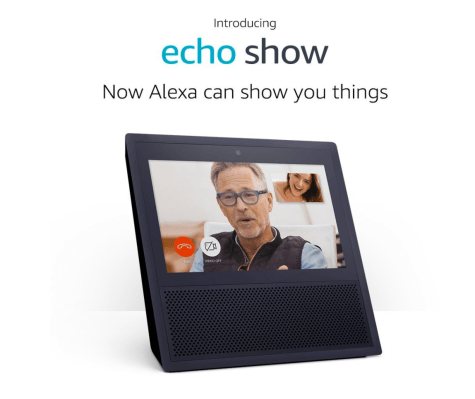Look out, world: Alexa is coming to a screen near you. Today Amazon unveiled the Echo Show, a WiFi-enabled home device with a seven-inch screen that is the newest addition to its Alexa-powered Echo range of home hubs that plays media and responds to voice commands.
While previous versions of the Echo have been all about asking Alexa questions and getting responses from her, this new device takes a more IRL turn: one of the main selling points is that you can use the Echo Show to make and take video calls, with other humans.
The device, which comes in black and white versions, will cost $229.99 and will be shipped from June 28, with preorders available now. It appears that it will be available first in the U.S. only.
For those who follow the company, the new device may not come as a surprise, following several leaks about the product before today, with two coming in the last week alone, one yesterday claiming the device would be unveiled today.
“Echo Show brings you everything you love about Alexa, and now she can show you things. Watch video flash briefings and YouTube, see music lyrics, security cameras, photos, weather forecasts, to-do and shopping lists, and more. All hands-free—just ask,” Amazon notes in its blurb on its product page. You can use the device for video calls and it looks like it will also integrate and enhance skills that you already use on the existing Echo, for example you can now see music lyrics for Amazon Music. It also has Dolby-powered speakers and eight microphones, and lets you use existing Alexa skills that do not have a video component. You can see more on how the Echo Show works in Romain’s run-down here.
The device’s potentially biggest feature — the calls and messaging — also herald’s Amazon’s move into a key, new area of services. Alexa Calling, as the feature is named, will also work on other Echo devices, and the Alexa app. More on this here.
The device weighs 41 ounces, nearly 1.1 kilos. It’s not a mobile phone replacement, that’s for sure!
A little slideshow of how it looks is here, and we’re embedding a video too below.
[gallery ids="1487132,1487133,1487134,1487135,1487136"]
Amazon first hit the market for voice-controlled home hubs with its Echo device, and it followed that up last month with a new iteration called the Echo Look that included a camera but not screen. That device is still only available on a limited basis.
The Echo has resonated with consumers and has been a runaway hit for Amazon. eMarketer estimates that the company will control 70 percent of the voice-controlled speaker market this year, amid competition from the likes of Google and Samsung.
With each device, Amazon has focused on different aspects of how it can utilise its advances in artificial intelligence to further advance what you can expect from its hardware.
The Echo has found a lot of success through the growth of a larger ecosystem of services that integrate with the device — the so-called “skills”. These enable people speak to it in regular “natural language” phrases to get answers from a vast database of information, or to command it to do things for you along the lines of what you might have in the past ordered or purchased through a web interface, or via an app. All this gets enhanced with each question, courtesy of the machine learning engine Amazon has built to underpin Alexa.
The Look takes that one step further by bringing in computer vision, including a camera to expand the kinds of functionality and responses provided by the Echo. Of course, there are many ways that a camera could be used — and not all of them innocuous — so perhaps unsurprisingly Amazon has chosen to market the Look for some of the lighter applications.
In this case, the aim with the Look is to own it as a “hands-free camera and style assistant.” You keep the device in your bedroom or dressing room, and use the camera to take selfies. Alexa then “reads” these selfies and gives you ideas on what to wear — and likely what to buy, given Amazon’s large ambitions in the fashion/apparel space.
The newest device, meanwhile, takes everything one step further. You can now not only ask the device questions or command it to do things like order food for delivery, or dim your connected lights, but you can see things now, too. The fact that so many people have cut off their fixed phone line connections or never use them, opting instead for cell phones, gives the company a window of opportunity to develop a new kind of device to take that place. (Note: for now, you can’t yet capture images on the Show. You need the Look for that.)
Beyond that, though, there are so many more things that this can lead to: for example, it’s just a small leap between the small screen of today’s device, and a larger console that can replace the main TV in the room. Considering Amazon’s other efforts in media, specifically with Prime Video and its Fire Stick to enable on-demand channels and Amazon services, you can see (literally and figuratively) where this might be going.
What’s also interesting, for the Amazon nerds among you, is to see how Amazon pieces all of its products and strategies together over months and years, pulling things from here and there and everywhere. As we uncovered, Amazon last year quietly acquired a video conferencing startup called Biba. Some of that tech has made its way into AWS’s enterprise services, but now can you can see how it may also be very much flowing into Amazon’s consumer plays, too.
